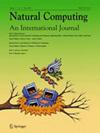ALCH: An imperative language for chemical reaction network-controlled tile assembly
IF 1.6
4区 计算机科学
Q3 COMPUTER SCIENCE, ARTIFICIAL INTELLIGENCE
引用次数: 3
Abstract
Schiefer and Winfree recently introduced the chemical reaction network-controlled tile assembly model (CRN-TAM), a variant of the abstract tile assembly model (aTAM). In the CRN-TAM, tile reactions are mediated via non-local chemical signals controlled by a chemical reaction network. This paper introduces ALCH, an imperative programming language for specifying CRN-TAM programs that can be compiled and simulated. ALCH includes standard language features such as Boolean variables, conditionals, loops, and CRN-TAM-specific constructs such as adding and removing tiles. ALCH also includes the branch and parallel structures which harness the nondeterministic and parallel nature of the CRN-TAM. ALCH also supports functional tileset specification. Using ALCH, we show that the discrete Sierpinski triangle and the discrete Sierpinski carpet can be strictly self-assembled in the CRN-TAM, which shows the CRN-TAM can self-assemble infinite shapes at scale 1 that the aTAM cannot. ALCH allows us to present these constructions at a high level, abstracting species and reactions into C-like code that is simpler to understand. We employ two new CRN-TAM techniques in our constructions. First, we use ALCH’s nondeterministic branching feature to probe previously placed tiles of the assembly and detect the presence and absence of tiles. Second, we use scaffolding tiles to precisely control tile placement by occluding any undesired binding sites. This paper is an extension of our previous work, updated to include a Sierpinski carpet construction and the parallel command.ALCH:一种用于化学反应网络控制瓦片组装的命令式语言
Schiefer和Winfree最近提出了化学反应网络控制的瓷砖组装模型(CRN-TAM),这是抽象瓷砖组装模型(aTAM)的一种变体。在CRN-TAM中,化学反应通过由化学反应网络控制的非局部化学信号介导。本文介绍了一种命令式编程语言ALCH,用于指定可编译和模拟的CRN-TAM程序。ALCH包括标准的语言特性,如布尔变量、条件、循环,以及特定于crn - tam的结构,如添加和删除tile。ALCH还包括利用CRN-TAM的不确定性和并行性质的分支和并行结构。ALCH还支持功能瓷砖集规范。利用ALCH,我们证明了离散Sierpinski三角形和离散Sierpinski地毯在CRN-TAM中可以严格自组装,这表明CRN-TAM可以在尺度1上自组装无限形状,而aTAM不能。ALCH允许我们在高层次上呈现这些结构,将物种和反应抽象为更容易理解的类c代码。我们在我们的结构中采用了两种新的CRN-TAM技术。首先,我们使用ALCH的不确定性分支特征来探测组装中先前放置的块,并检测块的存在和不存在。其次,我们使用脚手架瓷砖来精确控制瓷砖的放置,通过遮挡任何不需要的结合位点。本文是我们之前工作的延伸,更新了包括Sierpinski地毯构造和并行命令。
本文章由计算机程序翻译,如有差异,请以英文原文为准。
求助全文
约1分钟内获得全文
求助全文
来源期刊

Natural Computing
Computer Science-Computer Science Applications
CiteScore
4.40
自引率
4.80%
发文量
49
审稿时长
3 months
期刊介绍:
The journal is soliciting papers on all aspects of natural computing. Because of the interdisciplinary character of the journal a special effort will be made to solicit survey, review, and tutorial papers which would make research trends in a given subarea more accessible to the broad audience of the journal.
 求助内容:
求助内容: 应助结果提醒方式:
应助结果提醒方式:


